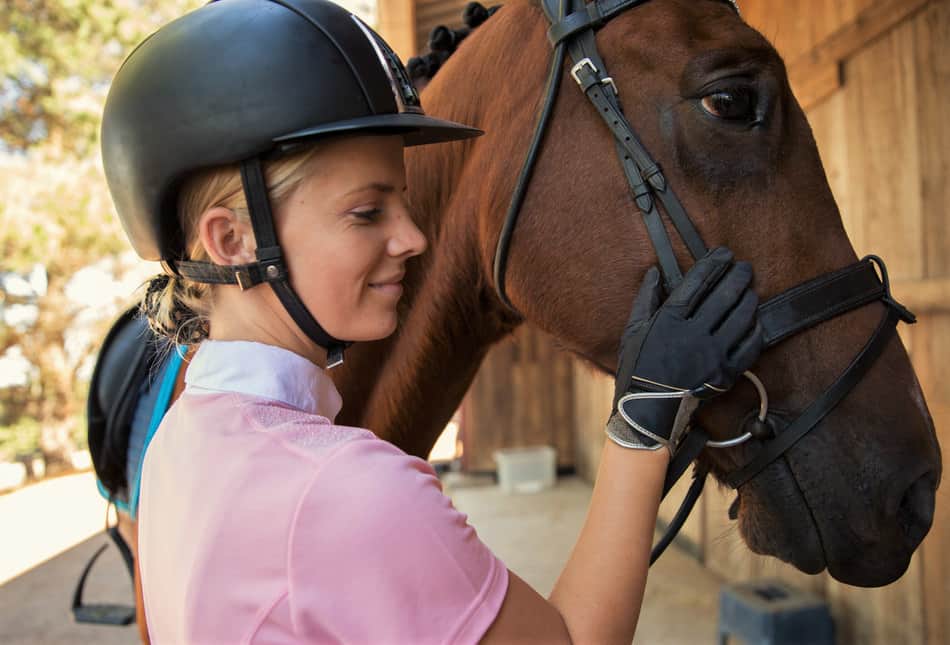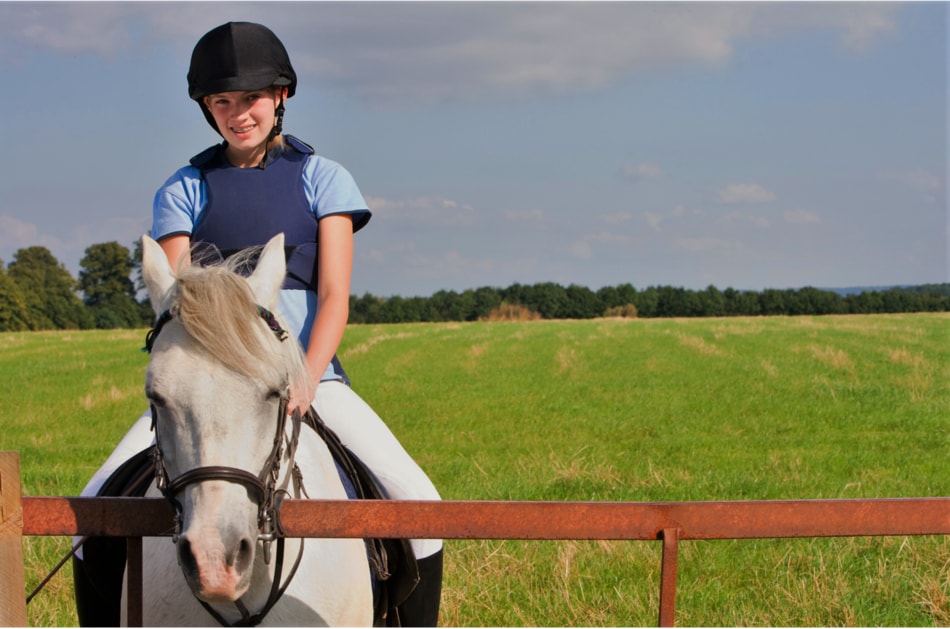
Horse riding is a wonderful sport, so congratulations on taking the plunge and deciding to get involved! When you take up a new activity, you’re bound to have lots of questions and one thing that tends to play on people’s minds is what clothing and equipment they need to get. Not just for safety, but to fit in and feel at ease when showing up for the first time. Well, fear not! After reading this guide and following our simple tips, you’ll stroll into your first lesson full of confidence, knowing exactly what you need to ride a horse.
As with most sports, there are some risks involved and therefore we recommend some safety equipment and items to make your ride more comfortable.
You will need:
- a certified, purpose made riding helmet
- gloves that are snug and have some grip
- closed shoes with some grip and a small heel
- close fitting, comfortable clothing
None of these things means you have to go out and spend the earth before you’ve even gotten started. For your first few lessons, you will be able to rent or borrow the essentials. Once you’ve discovered that you love it (and you will!) then you can go ahead and make your first purchases. Further down the line, you may want to invest in a more specialized kit depending on your preferences and budget.
For Your First Lesson
Riding Helmet
This is an essential but expensive piece of kit. You probably want to make sure you are going to continue riding before spending all that money. Call the riding center and ask them if you can rent or borrow a helmet for your class. They are set up for beginners and will usually offer this as part of their service. Word to the wise; if the riding center indicates you don’t need one – choose a different riding center.
Footwear
When you ride, your feet are going to be in stirrups – think of these are your anchors! It’s important that a) your feet fit in the stirrups b) your feet don’t fall through the stirrups and c) nothing gets caught or tangled around the stirrup. With all of this in mind, you’ll need a shoe or boot with a closed toe, small heel, some grip, and no laces, buckles or clips. You can find a run-down of all the types of shoes that fit that bill in this article so you can rummage through your closets for a suitable pair.
If you have footwear in your wardrobe which fits the criteria, such as ankle boots or slip-on sneakers with a heel, then great! If you have something close, but with laces – such as walking boots – then you can roll a thick pair of socks over the top of the boots and the laces to ensure they don’t come undone or get tangled. Remember, this will only be for your first couple of lessons. Some riding centers rent or loan boots as well as hats so ask them if you are stuck.
Gloves
You don’t have to wear gloves when you ride but it can make things a whole lot more enjoyable if you do. If you can’t borrow any, then this would be the one small purchase you might want to make before that first lesson, especially if you’re riding in winter. They don’t need to be expensive but do need to have some grip on the palm and be thin enough that you can feel the reins through them. Numb, cold fingers will make even the most exciting new hobby a lot less pleasant. You can read all about our favorite riding gloves here.
Clothing
You need close-fitting pants that allow you to move freely and cover your whole leg. Leggings will do fine. If they are particularly thin then you might want to double up to offer more protection from chaffing. For a shirt, you’ll want something that doesn’t restrict your movements and is nice and comfy. Feel free to layer up if it’s going to be cold but don’t go overboard as you’ll get warm pretty quickly! If it’s wet weather and you’re outside, a lightweight rain jacket will also be great. Oh, and comfortable, snug, stretchy underwear is a must. Ladies may want to think about a sports bra.

Welcome to Horse Riding!
You’ve had your first few lessons and decided this is more than a flash in the pan. Wonderful! You’re ready to start investing in your new hobby; what should come first? That might depend on the time of year it is and what you have been able to borrow, but these items should be on the list:
Riding Helmet
You could continue to borrow or rent, but having your own will be so much more comfortable. Not only will it be a perfect fit, but it will be personal to you. This is not something you will need to buy again for a long time unless you drop it or have a fall, so do get the best that you can on the budget you have. Check out our helmet recommendations here.
Don’t be tempted to buy second hand, as damage to the hat is not always visible from the outside. Visit a shop where you can try different brands and sizes and a professional fitter can recommend which is best for you. They will only sell hats that meet the specified safety standards, but if you want to be sure, you can find more information on standards by location, as well as a ton of other helmet information, in this article.
Riding Boots
As you’ll have seen in the article linked above, there are a few different styles when it comes to riding boots. Long boots are more traditional and protect the calf, while shorter boots – called jodhpur boots, allow freer leg movement and are great if you have larger calves. Try both and see which feels best for you – it comes down to personal preference. You don’t need to buy anything fancy at this stage, and you can always upgrade when your first pair end up getting a little tired.
Breeches or Jodhpurs
Don’t go buying heaps of leggings because after you have your helmet and boots, you’ll want to think about buying yourself some jodhpurs. These are specially designed riding pants made of hard-wearing, stretchy fabric. They often have reinforced or silicone patches in the places where you experience the most friction while riding, such as the inside of the knees and the seat. I remember well the first time I rode in my first ever jodhpurs I got for my birthday. It was a very different riding experience and the grip it gave me in the saddle made me feel a lot more comfortable and safe (and also now I could fit in with the real horse riders…).
Riding Crop
The riding center may have loaned you one of these for the first few lessons. It’s a relatively cheap purchase and always nice to have your own, but by no means essential.
Horse Riding is My Life!
As you gain more experience in horse riding, you might start to try different disciplines or ride under different conditions, which will influence the items that you need or want to purchase.
All-Weather Wear
Eventually, you’re going to ride in different seasons. You might like to invest in a range of tops to suit a variety of weather. You’ll find lots of options on the market, such as long sleeve tops offering sun protection or short sleeve tops with mesh panels and moisture-wicking fabric. As with any exercise clothing, there are lots of options so it’s just about figuring out what works best for you.
Invest in a good riding jacket. Unless it never rains or gets cold where you are, you’ll need a jacket. Even riding indoors can get mighty chilly in the winter! A regular jacket is fine, but you’ll find the fit and style of a purpose-made riding jacket is far better suited to the postures and movements you need to make. If you do have to ride in the rain frequently, beware of ‘shower-proof’ options. These are not usually robust enough to stand up to an unexpected downpour. For the ultimate in rain protection, go for a full-length waterproof riding jacket; this will cover your legs as well, even while you are on board.
Nice to Have
Helmet Silk
This is just a piece of fabric with a stiff peak that fits over your helmet; non-essential but will make your helmet look the part and also personalize it to you.
Dressage Whip
This is longer than your riding crop and is designed to help with schooling a horse. You’ll only need this once you have mastered the basics and have more control over your position when riding, or if you are going into dressage as a discipline.

Competition
If you’re going to start competing in dressage or show jumping, you’ll most likely need a show jacket, tie, and long riding boots.
Safety
For advanced safety, especially if trail riding or jumping, consider purchasing a back protector. There are many types on the market, offering varying degrees of protection. Event riders often use an inflatable style that attaches to the saddle and deploys if they fall, but you are unlikely to need one of these. Like your helmet, if you decide to buy a back protector because you are doing more adventurous riding, then buy the best you can with the budget you have.
As you go through your horse-riding journey, safety and comfort will always be the key factors to keep in mind when thinking about what you need to ride a horse. With both taken care of, you can have unlimited amounts of fun, learning new skills, and exploring different ways to enjoy the sport. You’ll see lots of equipment and accessories along the way that seem cool or look good, but if you have a limited budget then invest in practical items and leave the rest for later. Enjoy the sense of freedom and connection that horse riding gives, and don’t worry about anything else. Good luck! We know you’re going to love it!


